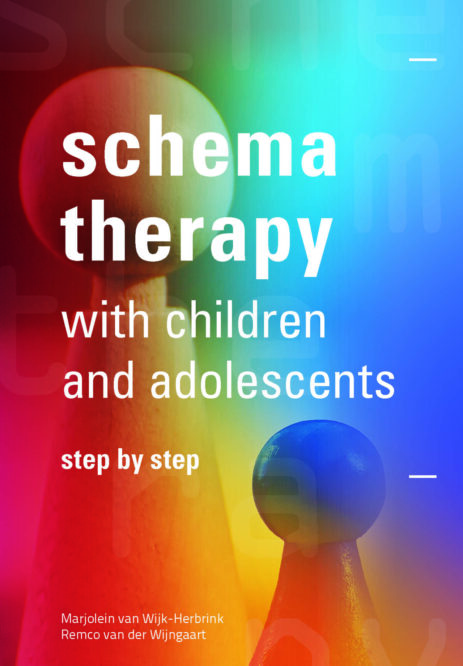- 1 Rationale of schema therapy for a patient with internalizing problems
- 2 Rationale of schema therapy for a patient with externalizing problems
- 3 Lifeline with unmet core emotional needs and development of schemas and modes
- 4 Downward arrow technique followed by diagnostic imagery
- 5 Creating a mode sequence of activated schemas in the parent-child interaction
- 6 Mode model and therapy goals
- 1 Providing care to an adolescent with internalizing problems
- 2 Providing care to an adolescent with externalizing problems
- 3 Imagery rescripting for the Vulnerable child mode
- 4 Venting anger for the Angry child mode
- 5 Chair technique stimulating the Angry child mode
- 6 Chair technique with the Undisciplined child mode
- 7 Happy child exercise
- 1 Chair technique with the Demanding critic
- 2 Chair technique with the Punitive critic
- 3 Imagery rescripting fighting the Guilt-inducing critic
- 4 Challenging the Punitive critic in a playful way: A compilation
- 5 Cognitive technique fighting the Demanding critic
- 1.a Empathic confrontation of the Detached protector in the different phases of therapy - Initial phase of therapy
- 1.b Empathic confrontation of the Detached protector in the different phases of therapy - middle phase of therapy
- 1.c Empathic confrontation of the Detached protector in the different phases of therapy - final phase of therapy
- 2.a Empathic confrontation of the Self-aggrandizer in the different phases of therapy - Initial phase of therapy
- 2.b Empathic confrontation of the Self-aggrandizer in the different phases of therapy - middle phase of therapy
- 2.c Empathic confrontation of the Self-aggrandizer in the different phases of therapy - final phase of therapy
- 3 Providing direction as part of limited reparenting
- 4 Visualizing the Angry protector to connect with the Vulnerable child
- 5 Imagery rescripting (starting from a situation triggering a coping mode)
- 6 Step by step limit setting
- 7 Limit setting of the Bully and attack mode
- 8.a Chair technique with the Compliant surrenderer in the different phases of therapy - Initial phase of therapy
- 8.b Chair technique with the Compliant surrenderer in the different phases of therapy - middle phase of therapy
- 8.c Chair technique with the Compliant surrenderer in the different phases of therapy - final phase of therapy
- 9 Chair technique with substance abuse
- 10.a Flash card for a coping mode in the different phases of therapy a. Initial phase of therapy
- 10.b Flash card for a coping mode in the different phases of therapy - middle phase of therapy
- 10.c Flash card for a coping mode in the different phases of therapy - final phase of therapy
- 1 Therapy evaluation with the Healthy adolescent: the line exercise
- 2 Future imagery
- 3 Strengthening the Healthy adolescent with three chairs
- 4 Behavior modification: skills training in setting boundaries
- 5 Transitional object
- 1 Imagery rescripting with a parent to improve parenting skills
- 2 Mode clash between parent and child: chair work
- 3 Practicing healthy behaviors in imagery
- 1 Introduction to the schema therapy model – core emotional needs
- 2 Introduction to the schema therapy model – schemas
- 3 Mode sketch with a child
- 4 Mode work with finger puppets
- 5 Mode sketch with a parent
- 6 House of generations (1)– explaining the link between parental difficulties and the parent’s childhood.
- 7 House of generations (2) – reparenting own inner child and using positive schemas
- 8 Strengthening the Healthy modes of parent and child
- 9.a Skills training for a parent using a live puppet - initial phase of therapy
- 9.b Skills training for a parent using a live puppet - middle/final phase of therapy
- 10 BONUS: Session of skills training for a parent using a live puppet
- 1 Emotional deprivation
- 2 Abandonment
- 3 Mistrust/Abuse
- 4 Defectiveness/shame (patient with internalizing problems)
- 5 Defectiveness/shame (patient with externalizing problems)
- 6 Social isolation
- 7 Failure
- 8 Insufficient self-control
- 9 Subjugation
- 10 High standards
- 1 Vulnerable child (patient with internalizing problems)
- 2 Vulnerable child (patient with externalizing problems)
- 3 Angry child (patient with internalizing problems)
- 4 Enraged child
- 5 Undisciplined child
- 6 Happy child (patient with internalizing problems)
- 7 Happy child (patient with externalizing problems)
- 8 Demanding critic
- 9 Punitive critic
- 10 Compliant surrenderer
- 11 Avoidant protector
- 12 Detached self-soother
- 13 Self-aggrandizer
- 14 Bully & attack
- 15 Healthy adolescent (patient with internalizing problems)
- 16 Healthy adolescent (patient with externalizing problems)
- 1 Identifying schemas (patient with internalizing problems)
- 2 Identifying schemas (patient with externalizing problems)
- 3 Identifying modes (patient with internalizing problems)
- 4 Identifying modes (patient with externalizing problems)
